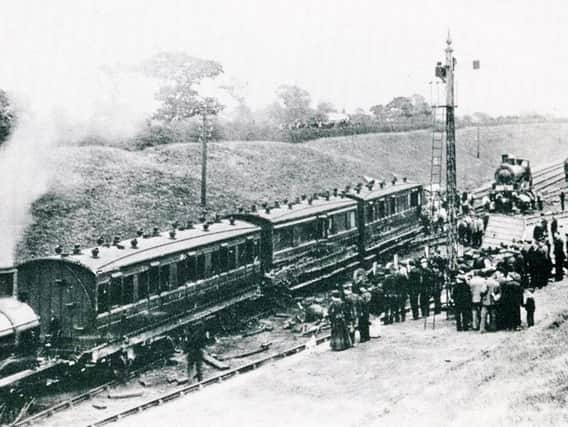Train driver's oversight led to passenger's death in Preston rail crash


Shortly before 9 o’clock in the morning on the first Monday of August 1896, a Bank Holiday, a fatal accident occurred at Preston Junction.
In those days the Lancashire and Yorkshire line branched off to Blackburn, about a mile and a half south of Preston where the West Lancashire Railway had running powers over the line from Preston to Blackburn.
Advertisement
Hide AdAdvertisement
Hide AdA West Lancashire train was entering the junction from Blackburn, when a L & Y excursion from Leeds to Blackpool ran out of a loop line on to the main line and collided with the train from Blackburn.
The driver of the excursion train, George Wigglesworth of Leeds, appeared to have mistook the signal given to the Blackburn train and exited the loop line too soon.
The third coach of the West Lancashire train, a saloon, was completely demolished, and of the two passengers therein one was killed and the other seriously injured. The unfortunate man killed was William Slater, aged 34, an overlooker at a mill near Chorley, who was found with his crushed head jammed between the broken woodwork having died instantaneously. The other passenger in that coach was the Rev. Warwick Adams of Southport who was taken out in a almost unconscious state, with blood pouring from his head. Besides those two victims another six passengers, mainly from the Brindle area, suffered from shock along with broken bones, bruises and contusions and needed hospital treatment.
Within days an Inquest before Deputy Coroner Wm. Ascroft was held at Bamber Bridge into the death of William Slater. Doctors from Preston and Lostock Hall had rushed to the scene and along with railway servants had tended to those in need. Passengers and railway officials alike described the harrowing scene and the tremendous impact of the crash.
Advertisement
Hide AdAdvertisement
Hide AdDaniel Wright, the driver of the West Lancashire train, told the inquest that as he was passing the loop, he noticed the Leeds excursion train begin to move in the same direction. He at once shut off steam, but the excursion train ran into the fourth carriage and smashed it.
George Wigglesworth, the driver of the Leeds train, said he had received a signal from his guard to proceed and finding that the signal ahead was not down had immediately applied the brake, but was too late to avoid a collision. Clearly there had been some misunderstanding of the signals received by the guard, who had observed a green flag, and subsequently the engine driver.
George Banks, the locomotive superintendent, gave Wigglesworth an irreproachable character reference. The coroner before sending the jury out remarked that a mistake had clearly occurred and it was their duty to decide whether there was gross and culpable negligence.
The jury found that the collision had occurred due to an error by Wigglesworth. The coroner concluded by saying that Wigglesworth had come very close to being charged with manslaughter and that the verdict should act as a great caution for him and other engine drivers.
Advertisement
Hide AdAdvertisement
Hide AdIn June 1897 after a long recovery the Rev. Warwick Adams returned to the pulpit at Christ Church in Blackburn and spoke of his ordeal saying that he had been so engrossed in reading a book that he remembered nothing of the accident when he woke up in hospital.
The Preston Junction was from 1952 known as Todd Lane Junction and it closed for passenger traffic in 1968, although it remained open for freight traffic until 1972 to serve the Lostock Hall gasworks.
The track bed is now a public footpath and cycleway.